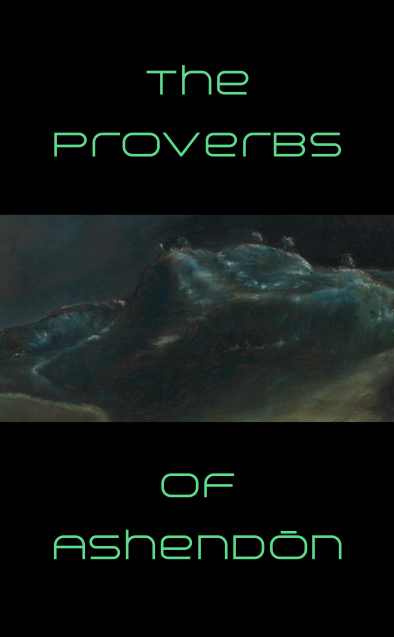
The Proverbs of Ashendōn. gnOme, 2017.
The litany of a parallel, venomous wisdom, The Proverbs of Ashendōn veer from the broken narrative of their initial occlusion, to the lucidity of theologico-literary madness as a new topography of knowledge. As an inverted deity, “Ashendōn comes bearing gifts.”
“Each page herein has a pair of proverbs, each pair apparently procreating further pairs—further proverbial couplings—unto and until the very last one, which understandably stands as a symbol not only of the whole endeavor (The Proverbs of Ashendōn) but also, and all the more so, of these ‘Proverbs’ as ashen ‘Postverbs’: Postmortem/Post«mot» ‘Proverbs’. The Proverbs of Ashendōn are in hindsight—looking back from their last page (Spolier Alert!)—spelled-out, spilled-forth and spoiled to the point of putrefaction, petrification, and pulverized carbonation: a return to, and/or turn into ash. In the end, to quote Beckett’s Endon (morphic mirror of Beckett’s Murphy) or better yet—worse still—to quote the unnamed/unnameable Endon of Beckett’s Endgame, all that the reader will have seen in proceeding through The Proverbs will have been ashes, naught but ashes. In the end, in Ashendōn, nothing but ash: ashen grey, deathly white; the final symbol uniting the (w)hole is the ‘debased cornucopia’ (Ashendōn’s words) of a fitting funereal urn, ‘symbol of the age’. What appeared to be couplings—procreative pairings—were in fact only the ongoing onanism (‘onanistic…repetitive patterns as a kind of fuel’: an ongoing funereal fire) of one already expired, already post-pyre. … On the last page, Godot-like (Note here, now, that there is no need for Spoiler Alerts, since everything is already spoiled), the sole proverb states at last that ‘Ashendōn is coming’—ya viene Ashendōn—but at this point, in this pointed proverb (this singular one following page after page of pairings), it is evident that everything which could have come has already/onanistically come. All is here/herewith Ashendone.” — Dan Mellamphy
“The age of iron, our own age,…is…the #Kali_Yuga: the age of misery, misfortune and decrepitude. The age of iron has no other seal than that of #Death. Its hieroglyph is the skeleton bearing…the empty hourglass, symbol of time run out, and the scythe, reproduced in the figure seven, which is the number of transformation, of destruction, and of annihilation. The Gospel of this fatal age is the one written under the inspiration of Saint Matthew. #Matthaeus, the Greek #Matthaios, comes from #Mathema and #Mathematos, which means Science.…It is the Gospel according to #Science: the last of all but for us the first, because it teaches us that, save for a small number of the élite, we must all perish.” — Fulcanelli

No comments:
Post a Comment
Note: Only a member of this blog may post a comment.